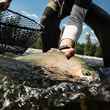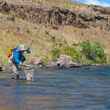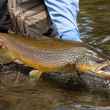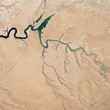The effort to stop a dragline mining project on the fragile fringes of the Okefenokee National Wildlife Refuge and its namesake blackwater swamp is just over five years old, and Alabama-based Twin Pines Minerals LLC already has draft mining permits in hand. Despite recent efforts from the U.S. Fish and Wildlife Service to exert control over regional groundwater rights and to expand the boundaries of the refuge, the Georgia Environmental Protection Division could conceivably issue final mining permits at any time.
Twin Pines wants to mine for titanium dioxide and zirconium in the “heavy sands” of Trail Ridge, and, in order to get at the minerals, it wants to strip the land bare and then pull a dragline through the sand at a depth of 50 feet, which, according to the Georgia Conservancy, is below the levels of the Okefenokee depression. The effort will remove nearly 1.5 million gallons of water a day from the Floridan Aquifer, largely as byproduct, as shallow groundwater will have to be constantly pumped out in order for the company to remove and process the sand.
Twin Pines maintains that its research and monitoring over the last six years show that its activity will not adversely impact the swamp or its water levels. Essentially, the company plans to dig up the top 50 feet of sand on the mining site, remove the minerals it seeks, and then replace the sand, leaving behind a reclaimed mine site. The company even says it will plant trees or seedlings on that reclaimed land. Previously, much of the land the company intends to mine was used for timber production.
Of note, the first phase of the proposed mine would be dubbed a “demonstration” mine on a 582-acre parcel. The company owns 8,000 acres on the edges of the refuge with one corner of the property coming within 400 feet of the refuge itself. The actual mine site is just three miles from the edge of the refuge.
Why could mining be problematic?
Two million years ago, Trail Ridge was a barrier island in the sea. The ridge marks the southeastern edge of the swamp and serves as a natural dam to contain the waters in the swamp and protect its biodiversity. The Okefenokee is a giant natural rain barrel, fed by groundwater and by precipitation within its basin. When it’s full, the swamp spills over into two iconic American rivers: the St. Marys, which flows to the Atlantic Ocean; and the storied Suwannee, that flows southwest through Florida to the Gulf of Mexico.
While there is little fear that Twin Pines’ mining activity could actually drain the swamp, scientists and hydrologists from scores of universities around the Southeast do worry that the initial mining effort could make drought conditions more common and lower water levels in both the swamp and in the St. Marys River. The swamp is home to hundreds of species of plants and wildlife, including some rare specimens like the red-cockaded woodpecker, the wood stork and the docile eastern Indigo snake, the largest snake native to North America. Under the water, the swamp is home to unique fish that handle the high acidity of the swamp’s tannic waters. Panfish like flyers and warmouth are found in Okefenokee, as well as long-nose gar, chain pickerel and the bowfin, which has inspired a cult following of fly fishers who ply the swamp’s dark waters in search of this prehistoric air-breather.
The river, as biologists are discovering, is still home to rare Atlantic and shortnose sturgeon. Atlantic sturgeon were once believed to be extinct in the drainage. Officially, the St. Marys marks the southernmost point on the map for the critically endangered fish, and both water quality and quantity are of the utmost importance to the fish and its little-understood spawning regime.
In the swamp, lower water levels mean exposing more of the Okefenokee’s peatlands. The bottom of the swamp, for several feet down, consists almost solely of peat. Peat is highly flammable — it’s a precursor to coal — and exposing it to air can cause it to dry out and become a very real fire hazard. In 2017, the West Mims fire in the swamp burned almost 153,000 acres of peatlands, long-leaf pine and cypress forests, and took more than three months to put out.
In short, the Okefenokee is a delicate and largely intact ecosystem that depends on the swamp’s hydrology to function.
Why is the Okefenokee so special?
The Okefenokee National Wildlife Refuge encompasses nearly 700 square miles in southern Georgia and a small slice of northern Florida. Contained within the refuge is the Okefenokee Wilderness Area, which, at nearly 354,000 acres, is the largest federally designated wilderness east of the Mississippi River. It’s also the largest blackwater swamp in North America — its dark waters are caused by tannins in the decaying plant material that the water drains through before settling in the swamp.
Within the Okefenokee, there is critical habitat for a number of rare and endangered plants and animals, as well some of the best habitat left in the South for American alligators, river otters, black bears, white-tailed deer, wild turkeys and a host of reptiles, amphibians and birds, both migratory and resident.
In quiet circles, so as not to be overheard, there are rumors that Florida panthers have found their way north into the refuge from the nearby Osceola Wildlife Management area and the Osceola National Forest in north Florida. Whether or not the protected cats have crossed into the refuge, there are long-standing efforts to reintroduce them there — they are native to the swamp, but it’s been a full century since the last one was documented there. A Florida panther was killed in Troup County, Ga., in 2008 — Troup County is located along the Alabama border in west-central Georgia, proof that the big cats can disperse and pioneer back into their former habitat. The last recorded panther was killed in the Okefenokee in 1925, when efforts to drain the swamp and harvest its cypress forests were still afoot. Just over a decade later, in 1937, President Franklin D. Roosevelt, by executive order, permanently protected the swamp.
In all, about half-a-million visitors come to the refuge each year to take in the stunning swamp scenery that includes vast swampy prairies and dense, moss-draped cypress forests. There’s no place else quite like it North America, which is why it’s now a candidate as a World Heritage Site under the United Nations Educational, Scientific and Cultural Organization (UNESCO), which would put it on the same list as places like the Great Wall of China, the Grand Canyon and the Galapagos Islands.

Mining, WOTUS and politics
Mining around the swamp is not unheard of — there are several mining operations — including dragline operations — in both north Florida and south Georgia. But Twin Pines’ mine permits are for Trail Ridge which serves to contain the swamp. In fact, the refuge’s new USFWS-initiated boundaries would include the ridge where Twin Pines wants to scalp the land to get at the titanium dioxide and zirconium.
The company first applied for both state and federal mining permits along Trail Ridge in July 2019. Those first permit applications asked for permission to fill in almost 600 acres of wetlands and 4,500 feet of ephemeral streams. It didn’t take long for environmentalists to catch wind of the permit applications, and just over a week after the permit applications were filed, the Southern Environmental Law Center organized a small band of conservation groups to examine the permits. The groups included the Georgia Wildlife Federation, the Georgia River Network and One Hundred Miles, a coastal conservation organization that got involved due to the potential impacts a mine could have on the St. Marys River.
On July 12, 2019, the U.S. Army Corps of Engineers started a three-month public comment process on the Twin Pines application that was submitted, at the time, under the requirements of the Clean Water Act — specifically the Waters of the U.S. rule that was put in place in the 2000s after the Supreme Court ruled that the Clean Water Act’s guidance on development in headwater streams and among seasonal or ephemeral streams was too ambiguous. During that public comment period, 20,000 people chimed in opposing the mining application. Over the next couple of years, the Corps’ application process spurred permit updates and new rounds of public comments (44,000 people from all 50 states chimed in during a 2020 public comment period after a new application from Twin Pines). Then, in April 2020, the first Trump administration’s EPA and the Corps published a politically directed rollback of the protections provided to headwaters and wetlands by WOTUS. This rule removed the protections of wetlands and ephemeral streams included in Twin Pines’ proposed mining parcel.
WOTUS, often just called the “Clean Water Rule” was a political football for a generation of politicians, until it finally cratered thanks to a Supreme Court decision in May of 2023 (Sackett v. the EPA). This definitively allowed Twin Pines to move ahead with its mining plans without a federal permit, as Sackett essentially codified the removal of federal oversight from headwater streams and wetlands. This is why the permitting process is now in the hands of the Georgia Environmental Protection Division, a much smaller agency that lacks the resources of the Corps or the federal EPA.
That doesn’t mean the feds butted out. Far from it. U.S. Secretary of the Interior Deb Haaland, after seeing the writing on the wall as WOTUS began to crumble, sent a letter to Georgia Gov. Brian Kemp in November 2022, asking the governor to direct the state agency to scrap the mining process. She cited the science and the very real concerns from hydrologists, biologists and others from Southern academia, noting that the proposed mine’s location had the potential to do real harm to the refuge.
“The Department has a profound interest in protecting the health and integrity of the swamp ecosystem,” Haaland wrote. “Home to the refuge, it is a unique wetland ecosystem unlike any other found in North America and is one of the world’s most hydrologically intact freshwater ecosystems.” She also noted that the refuge has significant cultural importance to the Indigenous Muscogee (Creek) tribe, and that it contains countless Native American artifacts, burial mounds and other culturally significant locations.
“The Department will exercise its own authorities to protect the swamp ecosystem and will continue to urge our State and Federal partners to take steps under their own authorities to do the same,” she concluded. “The swamp ecosystem is a treasure for the people of Georgia, our Nation, and the world.”
Despite numerous pleas to Kemp from private individuals, conservation groups, newspaper editorial boards and the like, to protect the Okefenokee, the governor opted not to take a position on the mine, but to, instead, let the permitting process play out.
Conservation interests gel and wade into the issue
It took some time, but a small core group of conservation organizations that started following the permitting process in 2019 has now grown into a coalition of environmental and conservation interests with a combined membership of more than 5 million people. But it’s the 11th hour, which doesn’t necessarily signal impending defeat for conservationists. Lots of conservation victories in recent American history took place in the 11th hour, from the protection of the Headwaters Forest Reserve in California in 1999 to the Bristol Bay Protection Act in 2024.
In fact, a recent blog post on the Theodore Roosevelt Conservation Partnership website equated the plight of the Okefenokee Swamp to that of Alaska’s Bristol Bay and Minnesota’s Boundary Waters as another great American landscape that always seems to be in the industrial development crosshairs. And, like the battles to protect those iconic landscapes, it will take a united front to overcome steep political tailwinds at the backs of Twin Pines and its scientifically panned mining plan.
If you ask the SELC, that unity exists.
“Everybody seems to agree that this is a bad idea,” said Megan Huynh, an attorney and the leader of SELC’s Wetlands and Coasts program. “We’re in a time where people are fiercely divided about just about everything … except this.
“It is just mind-blowing that we would put a place like the Okefenokee Swamp at risk for the profits of a mining operation on Trail Ridge.”
What’s next?
In its official response to overwhelming public opposition (more than 100,000 public comments with the vast majority in opposition) to the Twin Pines’ mining application that was revised in early 2023, the Georgia Environmental Protection Division had this to say:
“As a regulatory agency, EPD has the responsibility to follow the statutory and regulatory requirements of the Georgia Surface Mining Act and Rules for Surface Mining in determining if a surface mining permit shall be issued. If an application meets the requirements of the Georgia Surface Mining Act and Rules for Surface Mining, a permit is issued.”
In other words, “Rules are rules, and it doesn’t matter what the people say.”
It wasn’t a surprise, then, when GEPD issued draft mining permits to Twin Pines in February 2024. The department could conceivably issue final mining permits to Twin Pines at any time — nearly a year has passed since the draft permits were issued on Feb. 9, 2024.
There are several options for those interested in stopping the mining before it starts. First, and most obviously, the USFWS, under its new proposed boundaries of the refuge, could buy the land owned by Twin Pines, if the company were to become a willing seller (one of the stipulations of the new boundaries). In other words, the government could pay the company not to dragline Trail Ridge and threaten the ecological integrity of the swamp. The asking price might likely be pearl-clutching, as Twin Pines would likely ask for a return on its existing investments in the land and the mine planning, as well as on any future earnings the mining might produce.
Second, would be a quick rush to court for an injunction on mining the ridge. The basis for such an injunction could include avoiding an incursion on water rights owned by the USFWS, protecting the navigability of the St. Marys River should water levels drop, and preventing potential impacts on the Floridian Aquifer which is the source of drinking water for millions of people across Florida and southern Georgia. The courts could also file an injunction drawing on multiple Endangered Species Act triggers, ranging from potential impacts on everything from gopher tortoises and indigo snakes to whooping cranes and wood storks.
Third, a legislative solution could throw a wrench in Twin Pines’ mining engine. In 2024, the Okefenokee Protection Act in the Georgia statehouse had the support of more than half of the state’s General Assembly, but the bill couldn’t clear committee. The bill would have prohibited Georgia EPD from issuing any permits to mine near the Okefenokee National Wildlife Refuge. A second bill that would have put a three-year moratorium on mining permits in the basin failed on the last day of the 2024 session. Given the broad public opposition to a mine on the edge of the swamp, this option could be viable.
But, according to Huynh, if and when the EDP issues final permits to Twin Pines, and the permits issued look anything like the draft permits issued last year, the court option is the most likely.
“We’ve been following the process through Open Records Act requests since the draft permits were issued, and from what we’ve seen, our concerns are as strong as ever,” she said. “If those concerns aren’t addressed, I expect they’ll be challenged in court.”
Over the last year, SELC and its burgeoning conservation coalition have polled the people of Georgia, and the results might be the most heartening outcome to emerge from this complicated morass of drag lines, flammable peat and sand slurries.
“From our polling, 90 percent of Georgians want to protect the swamp,” Huynh said. “And 81 percent of Republicans polled in Georgia want to protect the swamp. This isn’t a partisan issue. The people of Georgia don’t want this.”
That ought to count for something.
































Comments